Arpaia M.L.; Kahn T.L.; El Otmani M.; Coggins C.W.Jr; Demason D.A.; O'connell N.V.; Pehrson J.E.Jr, 1991: Pre harvest rind stain of valencia orange histochemical and developmental characterization. Scientia Horticulturae (amsterdam). 46(3-4): 261-274
Pre-harvest rindstain of California [USA] cultivar 'Valencia' orange Citrus sinensis has economic significance since fresh fruit marketability is reduced. Quantification of the incidence of rindstain as related to tree quadrant has allowed us to designate quadrants where rindstain was most likely to occur (upper outside SW) or least likely (lower inside NE) to occur. Growth and development characteristics of fruit from the two quadrants were measured throughout fruit development. Significant differences in percent weight loss between fruit from the SW and NE quadrants occurred at color break and at commercial maturity. Structural and histochemical changes in flavedo tissue of fruit from SW or NE tree quadrants were monitored over the course of fruit development and maturation. First evidence of periderm formation occurred in October, coincident with observed changes in histochemical staining for lipids. These differences were increasingly evident as the fruit approached horticultural maturity and visual symptoms of rindstain developed. The development of a pronounced periderm in affected fruit suggests that rindstain is due to a physical trauma, although we do not believe it is caused by wind.
This from Mary Lu Arpaia in response from a Central Valley problem that cropped up recently. Fruit looked on the tree, but after getting it into the packing house, it started showing these symptoms
Here is her summation of the abstract above:
1) Fruit were predisposed to this problem as early as colorbreak. We found this out by doing some elaborate fruit manipulations in the field in the fall and looking at symptoms in the spring.
2) Symptoms really started to appear about this time of year and then progressively worse
3) There was a loose correlation to presence of citrus thrips in the previous year
4) Fruit isolations did not find much of anything but weak saprophytic fungi.
5) At this point, it's not clear what a grower can do to prevent it.
Rindstain on Ruby Red Grapefruit in the Hemet area was noted in the 1990's and the observation there was possible moisture from dew or rain focusing sunlight to cause the condition. So it's not really from even a general observation.
Attached Images:

